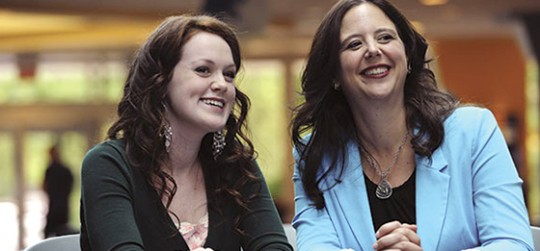The road to wellness
By Matt Semansky. This article originally appeared in the Spring 2014 issue of Dal Magazine.
Monica Brown has a pain in her stomach, a fist-sized passenger stowed away behind her belly button. Its effects, which are constant and vary only in intensity, include an agonizing swelling that Brown calls “The Bloat.” It is not a simple tummy-ache or the result of any commonly understood affliction like cancer or gastrointestinal illness. Since it escalated in severity at age 13, Brown’s pain has defied easy explanation and denied her a normal life, forcing her to miss months of school at a time.
Al Isnor, on the other hand, knows exactly what caused him to hit “rock bottom” several years ago at 24: Tourette’s Syndrome, with symptoms including such violent jerking of his head and neck that he required medication for the resulting pain. Isnor’s symptoms were threatening the steady hands he required in his woodworking job and despite trying countless medications and treatments, he hadn’t found any lasting relief.
Two different ailments. Two desperate patients. But after years of pain and frustration, Brown and Isnor were able to tap into the network of Dalhousie medical research. Their lives were about to get better.
Unravelling mysteries
When Dr. Christine Chambers (BSc’96) met Brown a decade ago, she saw a young girl suffering from both debilitating pain and the anguish of not knowing its cause. “It’s hard enough to be a teenager when you don’t have any health challenges,” says Dr. Chambers. “Then you layer on a mysterious disease, which is really what pain is.”
In addition to treating patients like Brown, Dr. Chambers is a Canada Research Chair in Pain and Child Health working out of the Centre for Pediatric Pain Research at the IWK Health Centre. Thanks to her efforts and those of her colleagues, Dalhousie has become recognized as an international leader in pediatric pain research.
“What we know about pain now is that it’s a very complex biological and psychological experience,” says Dr. Chambers. “Pain is an alarm system that’s supposed to go off when something in your body is wrong, but just like alarms can go off for no reason or be overly sensitive, that can happen in your pain system.”
Armed with that knowledge, Dr. Chambers worked with Brown with the hope of helping her manage her pain in a healthy way. With Dr. Chambers’ guidance, Brown found some relief in yoga, breathing and meditation, as well as medication. By explaining her research, Dr. Chambers also gave Brown the words to tell friends and family how she felt. Perhaps most importantly, Brown found in Dr. Chambers someone who could listen and understand.
“It was the first time in my life I felt believed.”
In contrast to the steady, incremental gains made by most medical researchers, Dr. Chambers says the field of pediatric pain lends itself to quick transitions between discovery and care. Her research into how parents respond to children in pain, for example, has already yielded new recommendations for parents, which Dr. Chambers has conveyed in a TEDx Talk and through a lighthearted YouTube video. “When parents try to offer reassurance, kids pick up on the fact that their parents are nervous and that anxiety seems to make the pain worse.”
Because pain research isn’t expressly tied to defeating a single major disease, Dr. Chambers says the field doesn’t generate much awareness or many resources. She says that in her field, bridging and matching funds can be essential to continuing important research or getting new research off the ground. For researchers working grant to grant, bridge funds can keep projects afloat between grants. Matching funds allow researchers to aim higher by seeking out research opportunities partially funded by external parties.
“Those types of funding are absolutely critical for researchers like myself who might be going from one grant to another, or who have an idea for something interesting and innovative but might need matching funds to make it happen,” says Dr. Chambers.
